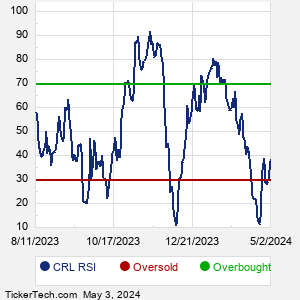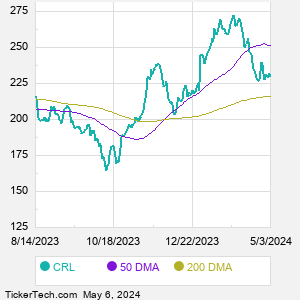Charles River Laboratories International is a full service, non-clinical global drug development partner. Co. has laboratory animal medicine and science (research model technologies) to develop a portfolio of discovery and safety assessment services, both Good Laboratory Practice (GLP) and non-GLP, that supports its clients from target identification through non-clinical development. Co. also provides a suite of products and services to support its clients' manufacturing activities, including its contract development and manufacturing organization business. Co. has three reporting segments: Research Models and Services, Discovery and Safety Assessment and Manufacturing Solutions.
When researching a stock like Charles River Laboratories International, many investors are the most familiar with Fundamental Analysis — looking at a company's balance sheet, earnings, revenues, and what's happening in that company's underlying business. Investors who use Fundamental Analysis to identify good stocks to buy or sell can also benefit from CRL Technical Analysis to help find a good entry or exit point. Technical Analysis is blind to the fundamentals and looks only at the trading data for CRL stock — the real life supply and demand for the stock over time — and examines that data in different ways. One of these ways is called the Relative Strength Index, or RSI. This popular indicator, originally developed in the 1970's by J. Welles Wilder, looks at a 14-day moving average of a stock's gains on its up days, versus its losses on its down days. The resulting CRL RSI is a value that measures momentum, oscillating between "oversold" and "overbought" on a scale of zero to 100. A reading below 30 is viewed to be oversold, which a bullish investor could look to as a sign that the selling is in the process of exhausting itself, and look for entry point opportunities. A reading above 70 is viewed to be overbought, which could indicate that a rally in progress is starting to get crowded with buyers. If the rally has been a long one, that could be a sign that a pullback is overdue. |



